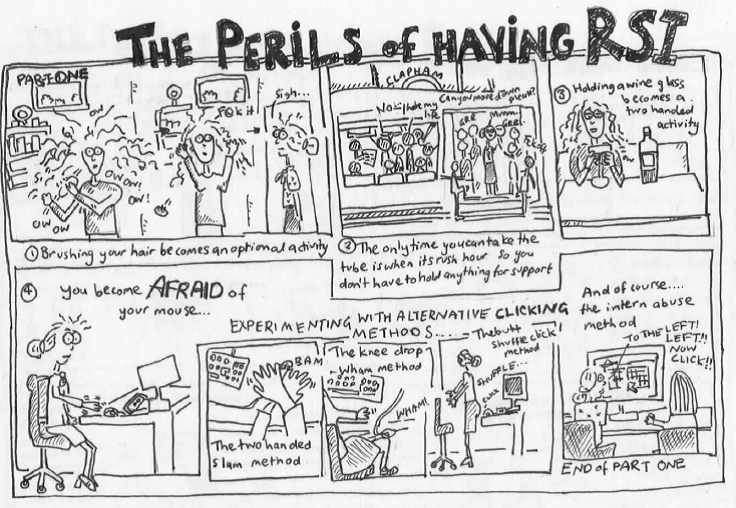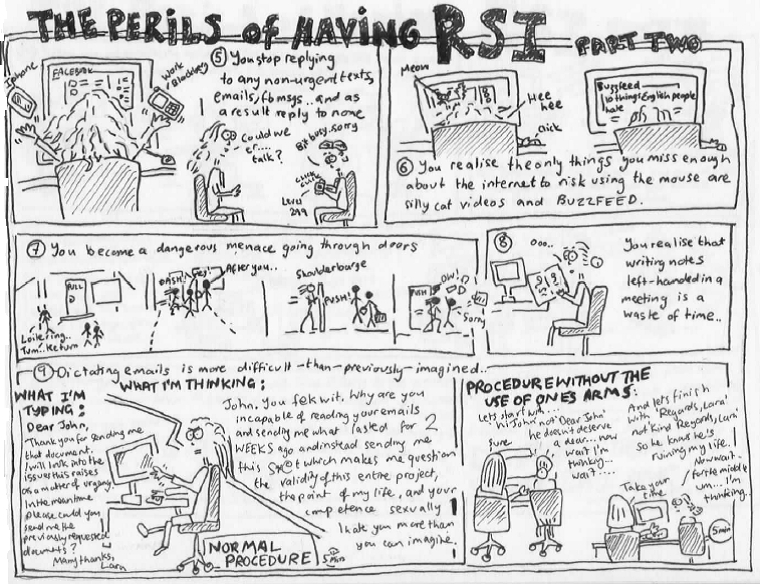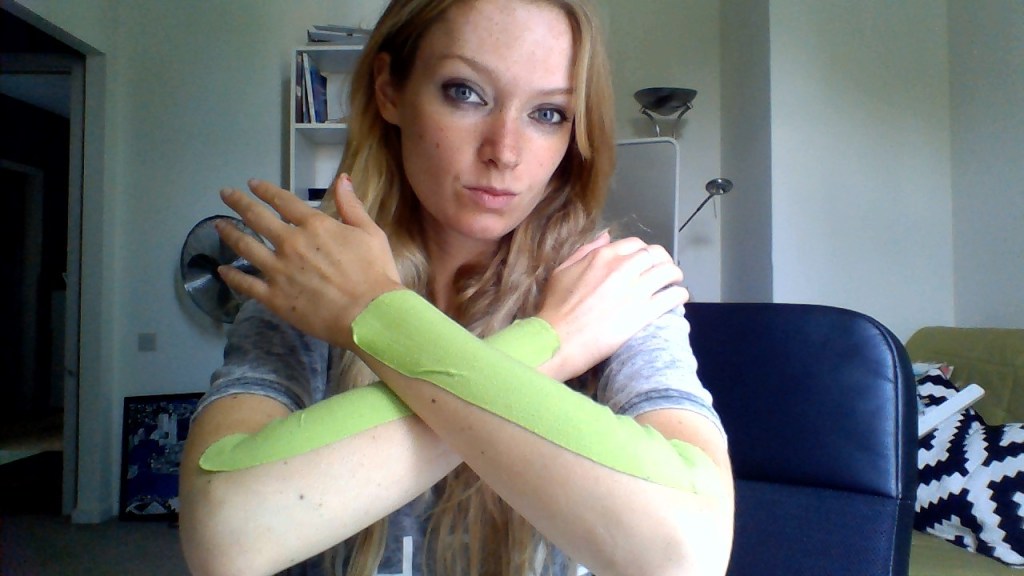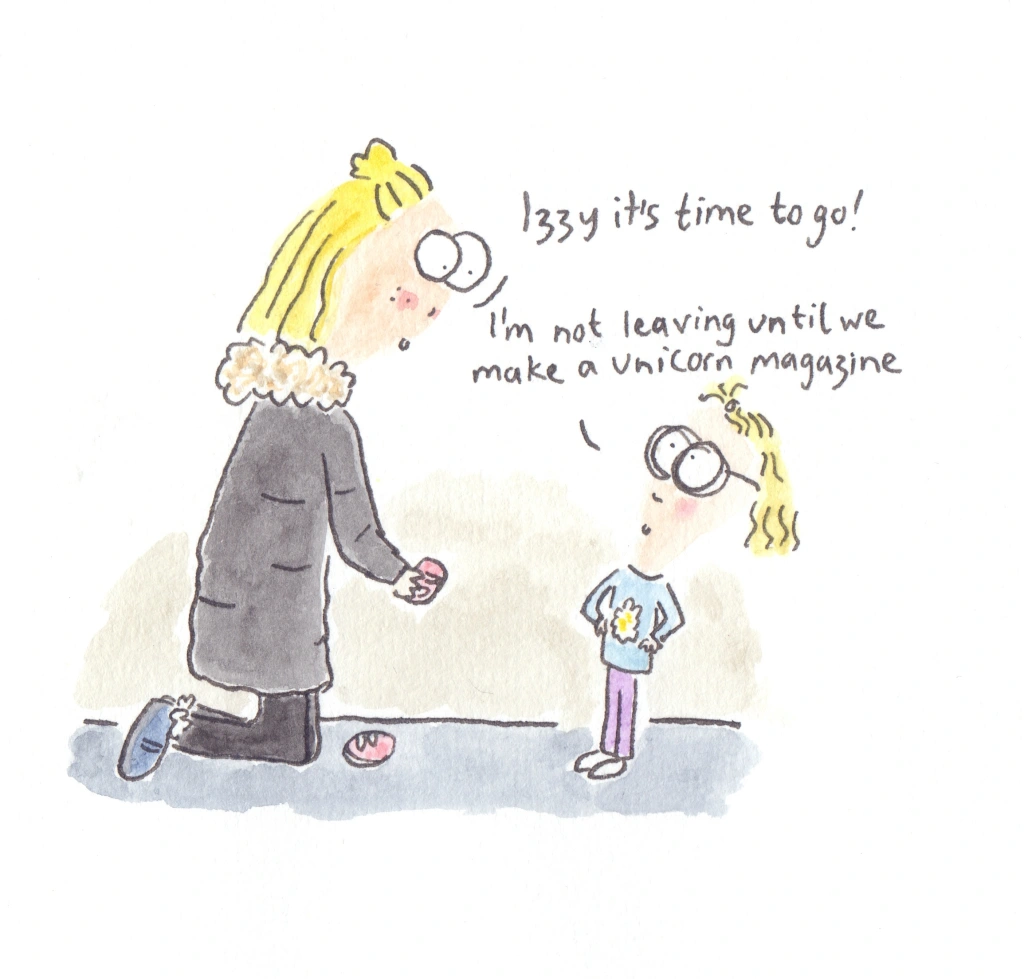My story: Way back in March 2013 whilst I was working in an office job in London, one Sunday morning I experienced a shooting pain down my right arm while I was cleaning the bathroom. This left me unable to use my right arm at all for a week, and then when I did start using it again, it only took a few days before it felt so weak I couldn’t do anything with it, and so I overloaded my left arm trying to do everything with it instead. After a few weeks it got to the point where both arms were in a constant state of pain just trying to carry out the minimum necessary daily tasks like eating.
I saw several doctors (including an expensive but terrible hand surgeon who wasted time testing me for arthritis, and the doctor of the company who I was working for who said I had depression- TRY BEING IN CONSTANT PAIN AND NOT BEING DEPRESSED DUDE), and it took ages to get a diagnosis of Repetitive Strain/Stress Injury or RSI. This is a very blanket term that covers a wide range of conditions. An ‘overuse’ injury is another commonly used term. Apparently I specifically have extensor muscle fascia pain in my right and left forearms. In essence the extensor muscles in my forearms were constantly contracted and unable to relax.
Even after taking a couple of weeks medically signed off work and afterwards having twice weekly physiotherapy for my arms and only working half days and using the computer much less (I dictated my emails to an intern in our open plan office which wasn’t fun for me or them) my arms still weren’t getting better, and 5 months in the pain was too much to handle. That’s when I decided I needed a total break from work, and to just focus on getting my arms better. Hence my escape from the rat race!



My Top RSI Tips: (Bearing in mind I am not in any way a doctor, just a patient who wishes they had done things differently from the beginning)
1) REST until the pain has stopped. I know how difficult resting your arms is, believe me – but in the long run the longer you rest at the beginning the shorter and less intense your overall injury period will be. Rest will mean wearing an arm splint day and night for at least a week, if not MUCH longer to help support your arm muscles during activities you can’t stop doing with your arms (like eating) .
2) From a good doctor/physio/hand therapist try to get an accurate diagnosis of what is causing your pain and where the source of the problem is, so that you can get the best treatment plan. I thought my pain was in my wrists because it hurt when I did things like typing or using the mouse, but the hand therapist I saw could actually feel the twists and lumps that were in the extensor muscles of my forearm that support my wrists. A doctor in Belgium also prescribed an ultrasound of my right arm, and it showed that I had some liquid build up in my wrist (which happens when there is inflammation), and a small tear in my brachial muscle (which wraps from your bicep down your forearm to your wrist), i.e. tennis elbow.
Knowing that professionals could see/feel the problem and that it wasn’t in my head really helped. RSI comes with a stigma of it being psychosomatic/a way to medically fake not having to go to work/get painkillers and some doctors just won’t believe you and will make you doubt yourself, so try not to be disheartened if it takes a while to find a doctor who can actually help. In the meantime…
3) Read ‘it’s not carpal tunnel syndrome!‘ (if you are experiencing any kind of upper body pain that you think is linked to your work stop everything and READ IT NOW!!!). It has great daily stretches to reduce pain, and tips to ergonomically improve your office set up – including for voice recognition software.
4) Pain management: Flexium gel and Biofreeze are very good for pain management. I also found using a heat rub gel when the muscles felt tight but not sore was helpful. When the pain was at its worst I was prescribed a low dose of Amitriptylin (Redomex) for patients who are in chronic pain- speak to your doctor if you think you may need this.
5) Bi-weekly physio during the rest phase and the following rebuilding of strength phase. I’ve had so many different types of physio: deep tissue massage, ultrasound acupuncture, Transcutaneous Electrical Nerve Stimulation (TEMS), and very briefly shock wave treatment which was so painful the physio stopped immediately. The type of physio I found most useful was called ‘crochetage‘ in French – or hook treatment. It involved digging around in my arms with hooks to loosen the muscles, and then taping them up in between sessions. After four sessions I started feeling a big reduction in pain, and after several months there was a definite improvement in my strength.


6) Muscle strengthening exercises. I had some natural muscle strengthening exercises for my RSI after I gave birth to our first daughter in March 2015, and had to lift a baby of gradually increasing weight! Now both my daughters are too big to need carrying, I do need to get back into a daily weight lifting routine. I do swim twice a week though, which I highly recommend as it exercises all the muscles in your back and neck too, so you put less strain on your arms.
Ten years on how am I doing? I should be able to go back to my office job by now right?
I feel like my recovery has plateaued at a point where I’m no longer in daily pain from doing my daily necessary activities like washing, cooking, food-shopping, cleaning, tidying and childcare. Which is not nothing, and believe me I am immensely grateful to no longer be in chronic pain. I no longer have to wear wrist splints- I only rarely will pre-emptively put them on if I know I’m about to lift something heavy. However, playing racket sports or bowling (which I used to really enjoy) are out of the question, and using a computer for more than a few hours a day a few days a week is a recipe for the pain returning. I can’t paint standing up- I have to paint or draw with my arm resting on the paper as I do it and I can’t do it for more than a few hours a day either. I have to stop myself scrolling on my phone and can only type a certain number of messages a day. I have it now, that stabbing feeling in my forearms from typing this (and most of it is copied and pasted from earlier blog posts). I still get nightmares about using a mouse.
I go through phases of reading all that I can about RSI and following patient support groups, and sometimes I feel like if I could just sort through all the information I would find a cure, but other times I just find it too sad knowing that so many people have such similar stories to mine and are suffering daily.
Prevention really does seem to be the only answer so if you are having any pains while working STOP AND STRETCH! And watch out for how much and how your children are using computers/smart phones/tablets/video games and teach them good posture and tell them to take frequent breaks – people younger and younger are becoming affected by RSI and it could have devastating effects on their lives.
I don’t know what the outcome would have been if I’d rested and gotten better treatment earlier, but as it stands I’m not sure I will ever be able to join the office rat race again. I think it would mean at the maximum only working part time but still having to spend so much time stretching and exercising and doing physio to prevent/alleviate the pain that I’d have no time for the rest of my life. So here is to remaining an escapee and making my own schedule cartooning!


